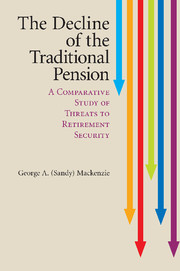Book contents
- Frontmatter
- Contents
- List of Tables
- List of Figures
- List of Boxes
- Acknowledgments
- Introduction
- PART ONE
- 1 The Development of Employer-Provided Pensions
- 2 The Economics of Employer-Provided Pension Plans
- 3 Issues in Funding and Investing
- 4 Current Regulatory Issues
- 5 Public-Sector Employer-Provided Pensions and Recent Innovations in the First Tier
- PART TWO
- Appendix 1 Ten Country Profiles
- Appendix 2 Mathematical Treatments and Derivations
- Glossary
- References
- Index
1 - The Development of Employer-Provided Pensions
Published online by Cambridge University Press: 05 June 2012
- Frontmatter
- Contents
- List of Tables
- List of Figures
- List of Boxes
- Acknowledgments
- Introduction
- PART ONE
- 1 The Development of Employer-Provided Pensions
- 2 The Economics of Employer-Provided Pension Plans
- 3 Issues in Funding and Investing
- 4 Current Regulatory Issues
- 5 Public-Sector Employer-Provided Pensions and Recent Innovations in the First Tier
- PART TWO
- Appendix 1 Ten Country Profiles
- Appendix 2 Mathematical Treatments and Derivations
- Glossary
- References
- Index
Summary
Introduction
Employer-provided pensions have a venerable pedigree. In England, the first employer to offer a pension is thought to have been King Henry III, who in 1269 awarded an aging and infirm retainer a pension of four pence per day (Lewin 2003, 32). For more than a millennium, monastic communities throughout Europe provided a pension in kind to those of their members who were no longer capable of toiling in the fields or in the monastic workshops. Perhaps the most famous pension arrangement in European history is Les Invalides in Paris, established by Louis XIV for the benefit of soldiers disabled by fighting his wars.
The development of banking and the monetization of European economies meant that pensions eventually came to be paid in currency rather than in kind. Even in the late nineteenth century, however, the pension remained an ex gratia benefit bestowed by established family businesses or governments on long-serving employees. It was not funded, either on the books of the business paying it or externally. In the United Kingdom, Hannah (1986, 13) notes that friendly societies that were organized around a trade or occupation and trade unions provided some limited support for old age, albeit to a lesser extent. “For almost all of the working classes, [however] working life continued until incapacity prevented it” (Hannah 1986, 13).
The modern pension is a much more complex social institution than its antecedents, and did not really become widespread in industrialized countries until well into the twentieth century.
- Type
- Chapter
- Information
- The Decline of the Traditional PensionA Comparative Study of Threats to Retirement Security, pp. 15 - 35Publisher: Cambridge University PressPrint publication year: 2010



